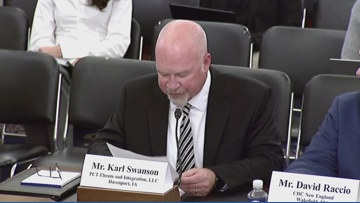Report on Budgetary Reductions to Washington’s Early Childhood Education and Assistance Program (ECEAP) and Implications for Sustainable Development Goals
Executive Summary
Recent legislative action in Washington State has resulted in a significant budget reduction of approximately $60 million for the Early Childhood Education and Assistance Program (ECEAP), a state-funded preschool initiative for low-income families. This decision directly contravenes the principles of several United Nations Sustainable Development Goals (SDGs), most notably SDG 4 (Quality Education), SDG 1 (No Poverty), and SDG 10 (Reduced Inequalities). The funding cuts have led to a statewide reduction in available preschool slots, threatening access to vital early learning and support services for vulnerable children and undermining progress toward equitable development targets.
Impact on Sustainable Development Goal 4: Quality Education
Setback for Early Childhood Education Access (Target 4.2)
The budget cuts represent a direct regression from achieving SDG Target 4.2, which aims to ensure all children have access to quality early childhood development, care, and pre-primary education. The consequences of this legislative decision include:
- A statewide reduction of approximately 12% in funded ECEAP slots.
- The postponement of the state’s universal ECEAP entitlement goal from the 2026-27 school year to 2030.
- The complete elimination of funding for an ECEAP pilot program for children under the age of three.
- Service providers, such as Northwest Educational Service District 189 (NWESD 189), are ceasing their ECEAP offerings after experiencing a nearly one-third reduction in their allocated slots.
These actions limit the availability of foundational education that prepares children for primary schooling, a key indicator for SDG 4.
Broader Implications for Sustainable Development Goals
Exacerbating Poverty and Inequality (SDG 1 & SDG 10)
ECEAP is a critical tool for addressing SDG 1 (No Poverty) and SDG 10 (Reduced Inequalities) by providing free, comprehensive services to children from low-income backgrounds. The program cuts have the following adverse effects:
- Increased Barriers for Low-Income Families: Reducing access to free preschool places a greater financial burden on families living in poverty, limiting their ability to participate in the workforce.
- Widening Educational Disparities: By limiting access for eligible children, the state is widening the educational achievement gap between children from different socioeconomic backgrounds, directly opposing the goal of reducing inequality.
- Service Reductions for Vulnerable Communities: Providers like Inspire Development Centers have been forced to close facilities, reduce services, and eliminate transportation in rural areas, disproportionately affecting marginalized communities.
Undermining Health and Well-being (SDG 3)
ECEAP’s model, based on the federal Head Start program, integrates health and wellness services, contributing to SDG 3 (Good Health and Well-being). The reduction in program capacity means fewer children will be connected with essential health care and other wraparound services required by state standards, potentially leading to poorer long-term health outcomes.
Negative Economic and Workforce Consequences (SDG 8)
The funding cuts also impact SDG 8 (Decent Work and Economic Growth). Staff layoffs have been reported by providers, contributing to job insecurity in the early education sector. Furthermore, a lack of affordable and accessible childcare options is a significant barrier to parental, particularly maternal, workforce participation, hindering overall economic growth.
Analysis of Systemic Challenges
Contributing Factors to Program Contraction
While the budget shortfall was the primary driver of the cuts, the ECEAP program faced pre-existing challenges that made it vulnerable. These issues must be addressed to ensure the long-term sustainability of early learning initiatives.
- Chronic Underenrollment: As of May, approximately 1,700 ECEAP slots across the state were unfilled, weakening the case for sustained funding.
- Workforce Shortages: Many providers have struggled to hire and retain qualified educators since the pandemic, making it difficult to operate classrooms even when funded slots are available.
- Competition from Alternative Programs: The growth of free Transition to Kindergarten (TK) programs in public schools has drawn eligible 4-year-olds away from ECEAP.
- Insufficient Funding Rates: Some providers report that the state’s per-slot payment is inadequate to cover the comprehensive, high-quality services mandated by the program, creating an unsustainable financial model.
Conclusion
The decision to cut funding for Washington’s ECEAP program marks a significant step backward in the state’s commitment to the Sustainable Development Goals. It directly undermines efforts to provide quality education, reduce poverty and inequality, and promote health and economic stability. While systemic issues like underenrollment and workforce shortages require strategic solutions, defunding a program proven to enhance kindergarten readiness for the state’s most vulnerable children is counterproductive to achieving a sustainable and equitable future for all.
SDGs Addressed in the Article
- SDG 4: Quality Education
- SDG 1: No Poverty
- SDG 10: Reduced Inequalities
- SDG 3: Good Health and Well-being
- SDG 8: Decent Work and Economic Growth
Specific SDG Targets Identified
-
SDG 4: Quality Education
- Target 4.2: By 2030, ensure that all girls and boys have access to quality early childhood development, care and pre-primary education so that they are ready for primary education.
Explanation: The article is centered on Washington’s Early Childhood Education and Assistance Program (ECEAP), a free preschool program for 3- to 5-year-olds. The budget cuts, which reduced funded slots for eligible children, directly hinder access to this pre-primary education. The article explicitly links the program to school readiness, citing a study that found “ECEAP alums were more likely to be ready for kindergarten.”
- Target 4.2: By 2030, ensure that all girls and boys have access to quality early childhood development, care and pre-primary education so that they are ready for primary education.
-
SDG 1: No Poverty
- Target 1.3: Implement nationally appropriate social protection systems and measures for all, including floors, and by 2030 achieve substantial coverage of the poor and the vulnerable.
Explanation: ECEAP is described as a program that “primarily serves low-income children” and provides “family support services.” This positions it as a social protection system for vulnerable families. The article details how budget cuts are shrinking this program, reducing coverage for the poor, as exemplified by Inspire Development Centers cutting its slots from 722 to 411.
- Target 1.3: Implement nationally appropriate social protection systems and measures for all, including floors, and by 2030 achieve substantial coverage of the poor and the vulnerable.
-
SDG 10: Reduced Inequalities
- Target 10.2: By 2030, empower and promote the social, economic and political inclusion of all, irrespective of age, sex, disability, race, ethnicity, origin, religion or economic or other status.
Explanation: The program is specifically designed to reduce educational inequality by targeting “low-income children” and “kids with disabilities.” By cutting funding and reducing slots, the state is diminishing a key tool for promoting the social and educational inclusion of these vulnerable groups, thereby exacerbating inequality in access to quality early learning.
- Target 10.2: By 2030, empower and promote the social, economic and political inclusion of all, irrespective of age, sex, disability, race, ethnicity, origin, religion or economic or other status.
-
SDG 3: Good Health and Well-being
- Target 3.8: Achieve universal health coverage, including financial risk protection, access to quality essential health-care services…
Explanation: The article states that ECEAP is an “intensive program that not only educates children but also connects them with health care and other services that are required by state standards.” The reduction in program availability means fewer vulnerable children will be connected to these essential health services, which is a setback for achieving universal health coverage for this demographic.
- Target 3.8: Achieve universal health coverage, including financial risk protection, access to quality essential health-care services…
-
SDG 8: Decent Work and Economic Growth
- Target 8.5: By 2030, achieve full and productive employment and decent work for all women and men…
Explanation: The budget cuts have a direct impact on employment in the early education sector. The article notes that as a result of the cuts, there are “a lot of staff laid off.” It also highlights pre-existing workforce challenges, such as providers who “struggled to hire enough workers” and a “workforce was entirely depleted,” indicating issues with the stability and availability of decent work in this field.
- Target 8.5: By 2030, achieve full and productive employment and decent work for all women and men…
Indicators for Measuring Progress
-
Target 4.2 (Quality Early Childhood Education)
- Indicator: Number and percentage of funded slots for eligible children in pre-primary education programs.
Explanation: The article provides specific numbers that can be used as indicators of declining access. It mentions a statewide cut of “about 12%” of slots, a reduction from 70 to 49 slots for the NWESD 189 district, and Inspire Development Centers’ slots being reduced from 722 to 411. It also notes “about 1,700 slots across the state were unfilled.” - Indicator: Kindergarten readiness rates.
Explanation: The article implies this as a key performance indicator by citing a 2022 Washington State Institute for Public Policy study which found that “ECEAP alums were more likely to be ready for kindergarten.” This metric is used to measure the program’s effectiveness.
- Indicator: Number and percentage of funded slots for eligible children in pre-primary education programs.
-
Target 1.3 (Social Protection Coverage)
- Indicator: Number of children from low-income families served by social protection programs like ECEAP.
Explanation: The reduction in the number of funded slots serves as a direct indicator of decreased coverage for the poor and vulnerable. The article states “All but 16 of the state’s 62 ECEAP contractors saw reductions in their funded slots,” showing a widespread decrease in this social protection measure.
- Indicator: Number of children from low-income families served by social protection programs like ECEAP.
-
Target 8.5 (Decent Work)
- Indicator: Number of staff employed or laid off in the early education sector.
Explanation: The article explicitly mentions that due to the cuts, there are “a lot of staff laid off,” which is a direct indicator of job losses and instability in the sector. - Indicator: Vacancy rates for teaching positions in early childhood education.
Explanation: The article implies this indicator by describing how programs “struggled to hire enough workers” and that the “workforce was entirely depleted,” pointing to a high number of unfilled positions even before the cuts.
- Indicator: Number of staff employed or laid off in the early education sector.
Summary of SDGs, Targets, and Indicators
| SDGs | Targets | Indicators |
|---|---|---|
| SDG 4: Quality Education | 4.2: Ensure access to quality early childhood development, care and pre-primary education. |
|
| SDG 1: No Poverty | 1.3: Implement social protection systems for the poor and the vulnerable. |
|
| SDG 10: Reduced Inequalities | 10.2: Promote the social and economic inclusion of all, including persons with disabilities and those of low economic status. |
|
| SDG 3: Good Health and Well-being | 3.8: Achieve universal health coverage, including access to quality essential health-care services. |
|
| SDG 8: Decent Work and Economic Growth | 8.5: Achieve full and productive employment and decent work for all. |
|
Source: seattletimes.com







